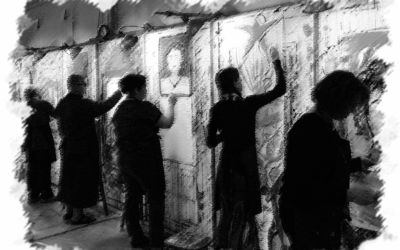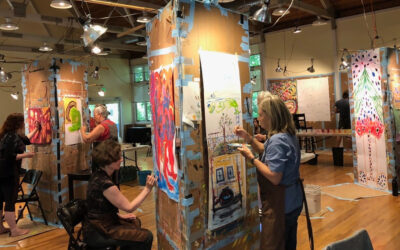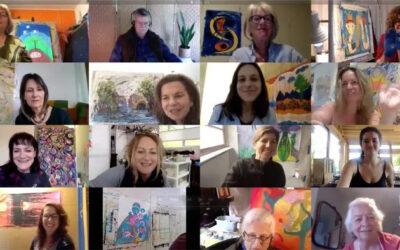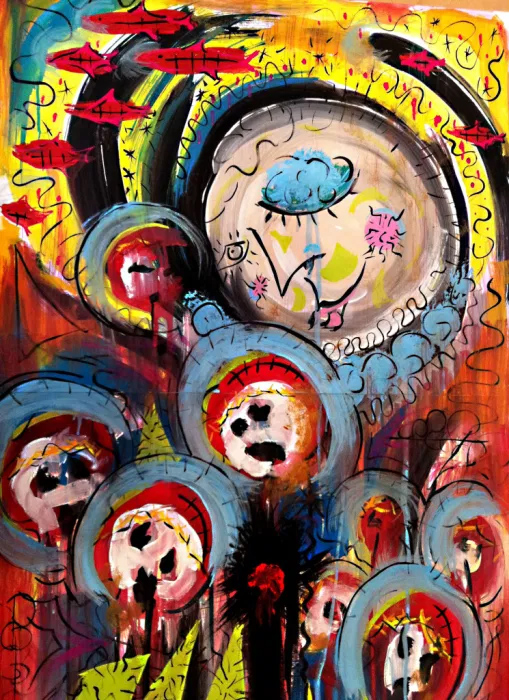
It is important to learn to use destructive energy in a creative way; if you don’t, it will turn against you.
An act of destruction usually brings a few seconds of pleasure, and this is why it is so tempting. But it leaves you with a bitter taste, a sense of failure. When painting for process, handling a destructive urge properly brings a sense of power, because then you begin to understand that anything can be used and expressed, no matter how dark, and then nothing can stop you from creating.
Let Frustration Be Your Guide
Anyone who paints is familiar with the feeling of frustration. It is often hard to admit that we are upset, not interested in what we are doing. We fight to stay on the track of good behavior. If a workshop participant is asked whether he or she is feeling frustrated, the first answer is often, “No, I’m okay, I’m doing fine.”
Frequently, this is only a wish, a desire to convince ourselves. But we can’t play games with the painting process. The moment we don’t do what we need to do, frustration arises. The intelligence of our organism responds to the pressure of pretending that we feel something other than what we feel, or the tension of simply refusing to feel it. Frustration is born as the acceptable fights the unacceptable and the expected fights the actual.
Frustration is an extremely valuable tool. It is a safety valve designed to wake you up. When you are sidetracked in the process, tension rises in the body and warns you of the danger of following the old road where everything is stereotyped and dead.
Engaging a Destructive Urge Opens the Door to Change
Here’s a conversation with an open-minded painter that illustrates the process of engaging a destructive urge:
“If you were totally free in this moment, what would you do?”
“Well . . . I would put some blue here . . . a yellow line here . . . .”
“If there were no bad consequences of any sort, if you were really, really free?”
“I would tear up the painting. I hate it!”
“Yes. And what would you do with your brush if you could use the energy that makes you want to tear it up.”
“I would paint over everything with a big brush.”
“What color would you use?”
“Black!”
“What else could you do with the black if you didn’t cover everything?”
“I could outline the figure or accent the clouds.”
“No. I am asking if you were using the black and your feeling together, what new image would come out of it? To cover the whole painting is a destructive act, but to find an image or shape that carries the feeling of destruction is creative.”
“I don’t understand.”
“You told me you wanted to destroy the painting. Could you do it creatively? Is there an image that could attack or destroy your painting? Which part would you attack first?”
“Oh, that house!” The painter pointed to a blurry image she had been struggling with for a long time.
“What could you do to attack it?”
“It could be struck by lightning!”
Something clicked. The painter’s feeling and action connected, like two electric wires touching. She woke up.
“Oh, I see! I just have to paint what I feel.”
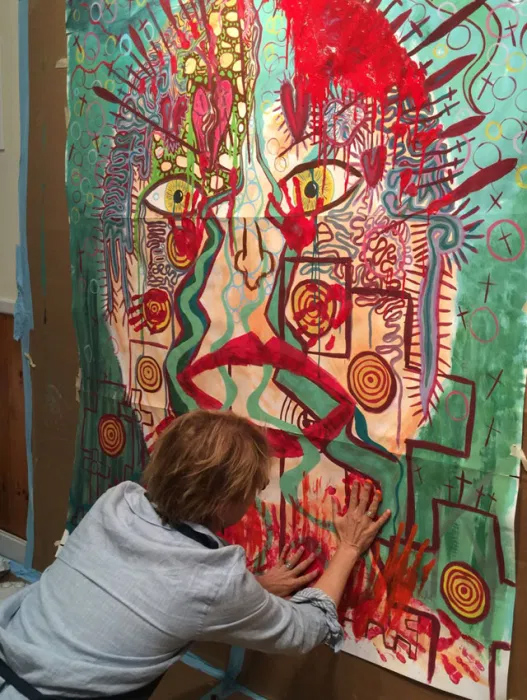
Using the Energy of Violence for Creation
To use the energy of violence for creation instead of destruction is a fascinating process. We are afraid we won’t be able to contain these intense feelings, that we will start screaming, destroy the painting, or even hurt people if we feel our anger. How little logic there is in that! To react to it in the world wouldn’t be good, but to express it, to let it run through us, to give birth to its shapes and colors and follow its evolution to see its roots, to free it from the cage of the body-mind, how could that be dangerous? If anything is dangerous, it is to not paint it.
When children play they take their trucks and dolls and bump them together. They like to drop things on the floor, and if they make noise, they love it even more. They hit the doll, they attack their parents with a “bang bang.” Is there anything wrong with this? If you told them not to do it, they would have to repress a natural part of their being.
Maybe this “bang bang” that we worry about is just a release of pressure, like the cracking of the seed. When a seed sprouts, it is a violent process. The skin breaks and splits in two. Something dies and something is born. Any time you paint a strong or violent image, you may be expressing that part of yourself that’s opening in order to let the new emerge.
Learn More
This article is adapted from the book Life, Paint and Passion: Reclaiming the Magic of Spontaneous Expression, co-authored by Stewart Cubley.
To learn more about process painting, see Why Paint for Process?
To find out about opportunities to participate in The Painting Experience, see our Programs.

